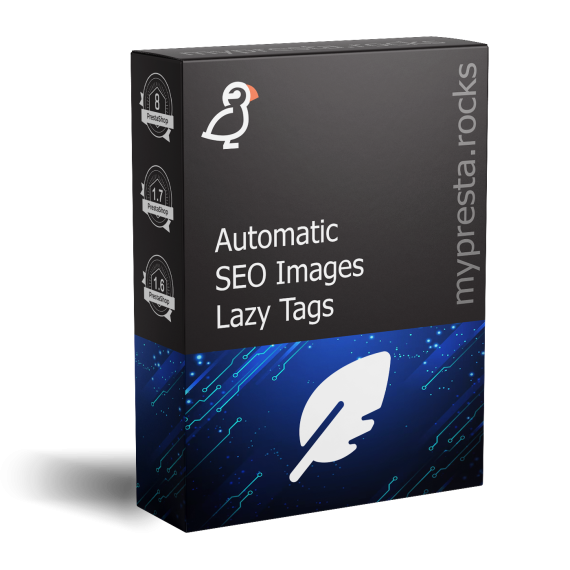



Boost your store’s loading speed and improve user experience with Automatic SEO Images Lazy Tags, a plug-and-play PrestaShop module designed to automatically implement lazy loading on virtually every image in your shop. The module scans your site’s entire output before sending it to the user, adding the “lazy” attribute to images that don’t already have it—while allowing you to define specific classes or CSS selectors for exclusion. For instance, images marked with .no-autolazy will be skipped, preserving any special display or functionality you need.
What sets this module apart is its non-intrusive approach. It doesn’t alter database content, so your original image tags and store data remain safe. Instead, the transformation happens on the fly, ensuring compatibility with a broad range of themes and setups. You’ll also appreciate its coverage: from static areas like headers, footers, and menus to dynamic sections such as product pages, category listings, blog posts, and CMS pages, nearly every image benefits from lazy loading by default.
This focus on lazy loading offers both technical and SEO advantages. Faster-loading pages often rank better in search engine results due to better performance metrics and lower bounce rates. Plus, customers browsing your store on mobile or slow networks will appreciate the quicker, smoother experience. Configuration is simple: install, activate, and let the module handle the rest—no complicated settings to tweak. If you need specific exceptions, just add a custom class or use the default .no-autolazy rule. That’s all it takes to enjoy faster load times and an enhanced user experience.
Key Benefits
.no-autolazy ensures special images can be skipped effortlessly. 30 days return right
30 days return right
Easy return - no questions asked
 Plug & Play Modules
Plug & Play Modules
Install, set up and take profit
 Dedicated Support First
Dedicated Support First
Priority Help & Satisfaction Over Sales
Speed is essential in e-commerce. When pages load faster, visitors stick around longer and have a better overall impression of your brand—factors that ultimately contribute to higher conversion rates and better SEO. The Automatic SEO Images Lazy Tags module is designed with exactly that goal in mind: it automatically applies lazy loading attributes to your store’s images, reducing the initial page load time while maintaining your site’s full functionality.
At its core, the Automatic SEO Images Lazy Tags module emphasizes ease of use. After installing and enabling it, you’ll notice an immediate effect on your store’s images—no need to edit database records, theme files, or custom code. The module inspects your site’s rendered HTML on the fly, appending the necessary “lazy” attribute to any image lacking one.
.tpl files or your database.Some modules only handle images within product listings or specific theme sections. The Automatic SEO Images Lazy Tags module goes further, targeting practically every image your site serves to visitors. This includes:
No matter the page type, the module helps keep initial load times low by delaying the load of images that aren’t currently visible on the screen.
While lazy loading is hugely beneficial in most cases, there are scenarios where you might prefer to exclude specific images—maybe a logo or an image that needs immediate rendering for design or functional reasons. The module’s exclusion system is straightforward yet powerful:
.no-autolazy is automatically skipped. This is ideal for images that must load at the same time as the rest of the page for design or branding requirements.Lazy loading aligns perfectly with modern SEO and UX best practices. Here’s how it helps:
Unlike some lazy loading solutions that modify your original image URLs or product database entries, Automatic SEO Images Lazy Tags leaves your site’s core data intact. It intercepts the final HTML output and inserts the “lazy” attribute right before the page is delivered to the visitor’s browser.
E-commerce success hinges on delivering a smooth, responsive shopping journey. By deferring the loading of images that aren’t yet visible, pages feel more agile, and visitors can start interacting with content sooner. From quickly browsing product categories to reading blog posts, every touchpoint becomes more engaging and less likely to stall.
While lazy loading is highly recommended for most images, there might be cases where immediate loading is preferable:
With this module, you can fine-tune those exceptions by adding a simple class.
The Automatic SEO Images Lazy Tags module is built to accommodate ongoing PrestaShop changes. Whether you update your theme, install new modules, or adjust your product catalog, lazy loading remains in effect without additional steps. Any new images you add or sections you create will automatically adopt lazy loading, as long as they don’t have an exclusion rule attached.
The Automatic SEO Images Lazy Tags module packs a significant optimization punch with minimal effort. You can install it, let it run, and immediately witness improvements in page speed and user engagement. Its approach is safe (no direct database alterations) and flexible (custom exclusion classes), ensuring it adapts to your unique requirements.
Whether you run a small boutique with highly visual products or manage a sprawling online marketplace, lazy loading your images helps present your store in the best possible light—fast, responsive, and in tune with modern web standards. Don’t let heavy images slow you down. Embrace the next level of performance and SEO optimization with Automatic SEO Images Lazy Tags.